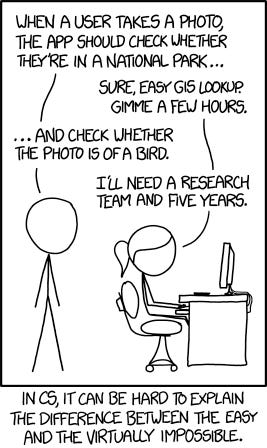Things I’ve learned in my 7 Years implementing AI
Even though the impacts of LLMs have never been seen before, they feel familiar to earlier assumptions.
For context: I wasn’t the “PhD scientist,” working on models. I was the guy who worked on productionizing their proof-of-concept code and turning it into something people could actually use. I worked in industries ranging from software/hardware automated testing at Motorola to small startups dealing with accessibility and education.
So here is what I've learned:
AI as a product isn’t viable: It’s either a tool or a feature
This AI hype cycle is missing the mark by building ChatGPT-like bots and “✨” buttons that perform single OpenAI API calls.
For example, Notion, Slack, and Airtable now lead with “AI” in their page titles instead of the core value they provide. Slack calls itself “AI Work Management & Productivity Tools,” but has anyone chosen Slack for its AI features?
Most of these companies seem lost on how to implement AI. A simple vector semantic search on Slack would outperform what they’ve shipped as “AI” so far.
People don’t use these products due to these “✨” AI solutions. The best AI applications work beneath the surface to empower users. Jeff Bezos comments about this (in 2016!)
You don’t see AI as a chatbot on the Amazon homepage. You see it in “demand forecasting, product search ranking, product and deals recommendations, merchandising placements, fraud detection, translations.”
That’s where AI comes in, not as “the thing” but as “the tool that gets you to the thing.”
The best use of AI is to trivialize hard problems
What if a problem that took a team of PhDs one year to solve could be solved better in four hours? That's when LLM shines:
When I worked on accessibility for nonverbal people, one of our projects aimed to make communication cards (“I want,” “Eat,” “Yes,” “No”) context-aware to allow nonverbals to express their desires faster, similar to an autocomplete.
For example, the user is home at 7 AM and taps “I want to eat” card.
The next cards should anticipate their needs (which are more likely to be breakfast items), but there are caveats: What a person typically eats for breakfast depends on their country, the type of establishment they are in (home, hotel, restaurant), the day of the week, and, of course, current personal preferences, which also change over time.
After a year of work, our team of researchers from two universities achieved a 55% rate (of the suggested options). It was a massive success at the time. We even won an award for best accessibility solution.
When ChatGPT 3.5 was released, I replicated a solution for this project and, after hacking over the weekend, got an 82% accuracy rate when running against the same test database.
There’s a reason we’re not seeing a “Startup Boom”
AI skeptics ask, “If AI is so good, why don’t we see a lot of new startups?” Ask any founder. Coding isn’t even close to the most challenging part of creating a startup.
What I do see is a boom in internal tools.
This year alone, I shipped projects that would never have been viable. As an engineering manager, spending weeks coding means neglecting the team.
The “Nice to have” bucket is when a project dies. It means there is no engineering capacity to tackle it, so it goes into the backlog limbo—until now.
Now, I can build these projects using Claude, running prompts, and reviewing the output between meetings. I see many people releasing new things that are incredibly helpful and productive, which would not have happened without Claude or Cursor.
LLMs won’t get much better, but that is okay
Like with all tools before it, we’re coming closer to the top of the S-curve for LLMs:

The last releases were unimpressive. Does anyone know a real application where ChatGPT 5 can do something that o3 could not?
The good news is that what we have is enough for most people. AI tools like KNNs are very limited but still valuable today.
This also kills the reverse FOMO: “If I wait for the technology to mature, I won’t have to deal with their earlier quirks,” is less relevant now.
But AI research is definitely not over: We will still see cheaper, faster, and open models, like those that can run on a mobile device and are as capable as ChatGPT 4o.
Ignore people trying to mystify AI
Creating AI models is hard, but working with them is simple. I put off implementing earlier AI tools because I couldn’t grasp how neural networks, sigmoids, and all that worked. Then someone said, “What are you doing? If you want to apply the technology, just use Scikit-learn.”
If you’ve never used AI for coding, install Claude Code and start using it for small tasks. That gets you 70% of AI’s current benefits without diving into prompt optimization or chain-of-thought mechanics.
Eventually, you’ll need to learn to leverage LLMs better when you hit bottlenecks. You will realize that you will still need to review code and CLI commands. You will naturally be better at prompting. You will know when and when not to use it.
AI is the new Agile: something simple, that makes you faster but has limits, yet people will position it as the solution for every problem, preaching: “Oh, you’re using (AI / Agile) wrong. In fact, it seems like what you need is even more of (AI / Agile)”
The tool has limits, especially when breaking new ground. LLMs are limited by their training data. For example, when I tried to vibecode a mod for a recently released Unity game, the AI failed to complete even a basic hook.
If You’re a Senior, You Won’t Be Replaced (It’s the Other Way Around)
Automatic railway gates replaced crossing attendants. But if those gates worked 99% of the time (or even 99.99%), would that be good enough?
LLMs are very far from being 99% accurate. They fix problems, but they tend to miss the root cause. I see many cases where the LLM suggested a fix by adding multiple lines, which an experienced engineer did by removing one.
Recognizing this requires senior-level skills, such as valuing simplicity over complexity and knowledge gained from dealing with similar bugs in the past.
This creates a problem for juniors, who, when using LLMs, will have problem-solving done for them and won’t develop this skill, hurting their code reviewing abilities. I see many companies that have stopped hiring juniors altogether.
Yes, we’re in a bubble, but that’s good for us
The Internet was a bubble in 1999, and you know the result. The internet died completely, but it was good for a while. Man, I miss the Internet.
But seriously, we are seeing great tools coming to boost productivity, a new era of AI memes, while VCs and Big Tech pay for most of them. It’s a win-win.
Also, here is my current favorite SORA video: (Warning: LOUD)
(I had to remove the video because a bug in Substack causes the space bar to play the video instead of scrolling down—sorry for the jumpscare. Here’s the Reddit link instead: https://www.reddit.com/r/SoraAi/comments/1nwcx9e/some_body_cam_footage/)




Great article! Totally agreed with a lot of this. I hate whenever companies like with "AI for X" instead of describing the problem they are solving. Steve Jobs is turning around in his grave right now.